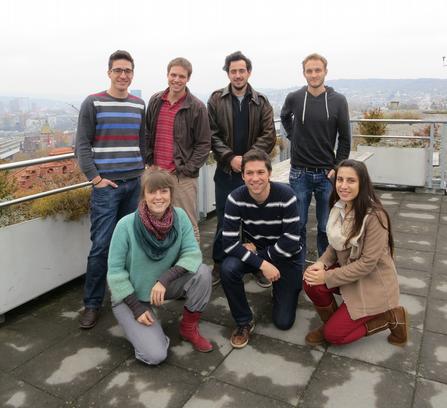MSc Students 2013-2014

Larissa De Palézieux dit Falconnet
Mountain Slope Hydrogeology of the Lago Bianco Pump Storage Project
Groundwater flow and groundwater pressures in alpine rock slopes are not well understood. This is mainly due to the fact, that these slopes have very heterogeneous permeability distributions and complex recharge/discharge conditions varying in space and time.For slope stability assessments or hydropower projects, the understanding of preferential groundwater flow and groundwater pressure distributions is of paramount importance. However, in comparison with porous aquifers in alluvial planes, very little is known about the hydrogeological conditions of alpine rock slopes. The objectives of this MSc thesis are to investigate carefully the geological and hydrogeological conditions on the Western mountain slopes of Valley di Poschiavo based on a large number of deep exploration boreholes that have been used for detailed geological and hydrogeological measurements.
Download Download the extended abstract (PDF, 280 KB)
Julian Felder
The influence of ice filled joints on rock slope stability
Berrak Firat
Tomographic Thermal Tracer Testing at the Widen and Melz site
Within this MSc project, a TTT will be planned, conducted and interpreted. Field experiments are planned at the well-equipped and well investigated Widen test site of the RECORD project (collaboration with Eawag) and / or at the Melz site. The objective of this thesis is to do an active TTT at the Widen site using four wells with multichamber-well casing. The task is to inject an “appropriate volume” of hot and/or cold water as well as a dye tracer together, and monitor depth- and time-dependent evolution of the responses at the observation wells. The experiment may be repeated with different injection volumes and temperature settings. For the interpretation of the results, both energy balance calculations and simple analytical simulation will be considered. If possible, a numerical models is set up and calibrated to the field data. Main questions will be the identifyability of flow and transport parameters, the role of aquifer heterogeneity, and macrodispersion.
Download Download the extended abstract (PDF, 98 KB)
Timothy Adriaan Iwan Overtveld
Analysis of artificial fracture paths in crystalline rocks formed under compression and tension with application to natural joints
There is a current debate if exfoliation joints, i.e., relatively young joints that are sub-parallel to today's or a former landscape surface, formed extensile in compression, with all three principal stresses being compressive (σ1 > σ2 > σ3 > 0), or if topographic perturbation of subhorizontal compressive, regional stresses (σ1 > σ2 > 0) caused a net tensile stress (σ3 < 0) perpendicular to the landscape surface.
Fracture paths in crystalline rocks are composed of intragranular and intergranular cracks. Their relative amount depends upon mineralogy, rock type, and stress state. Microscopical studies suggest that fracture paths and the ratio of intragranular to intergranular cracks, respectively, are dependent on the type of external loading (tensile or compressive). Variation in the ratio of intra- to intergranular cracks can lead to differences in fracture surface properties, such as fracture surface morphology (joint roughness). Thus, by investigating fracture morphology (fracture path) we might be able to distinguish between different loading conditions that led to fracturing.
Download Download the extended abstract (PDF, 165 KB)
Matthias Vogler
Driest Rockslide Mechanics
The general objective of this thesis is to relate in-situ measurements of ongoing rock mass deformation to the structural and mechanical conditions in an active rockslide near the Aletsch Glacier (Figure 2), and to investigate the mechanical conditions under which rockslides in brittle materials creep over long periods of time without catastrophic failure. The study will be based on the Driest rockslide (Figure 3), where we are currently dating the head scarp in order to characterize the landslide displacement history. The landslide is also the focus of past and ongoing displacement monitoring with satellite radar interferometry, photogrammetry and Total Station measurements from the opposite valley side. The topography in the surrounding area is alpine and steep, but partially accessible for detailed structural and rock mechanical investigations. The student will be supported by two PhD students working in area and have access to displacement information that ETH and Zurich University have collected during the last years.
Download Download the extended abstract (PDF, 857 KB)
Stefan Volken
Flims Rockslide Release Mechanics
The objective of the proposed MSc project is to study the structural and geomorphic controls on the Flims landslide. The research will focus on initiation and release mechanisms of the landslide. The interaction between endogenic and exogenic processes will be examined. The student will use engineering geomorphology techniques to create detailed morphology maps of the landslide. He or she will also apply terrestrial digital photogrammetry to areas of the landslide, creating a three-dimensional model database of the failure. The morphologic maps and photomodels, along with data from existing literature and engineering geology and geotechnical field investigations will constrain and validate two-dimensional models in continuum and discontinuum codes.
Download Download the extended abstract (PDF, 256 KB)
Patric Walter
Environmental degradation of clay shales